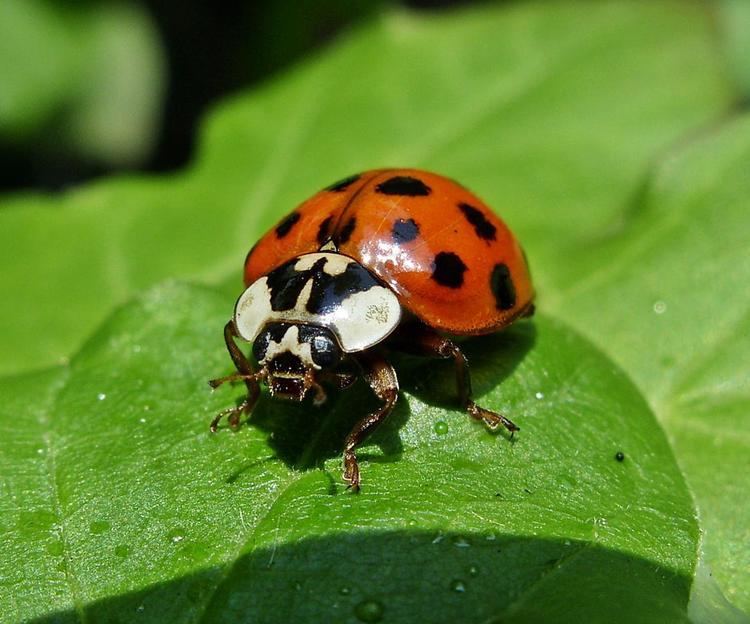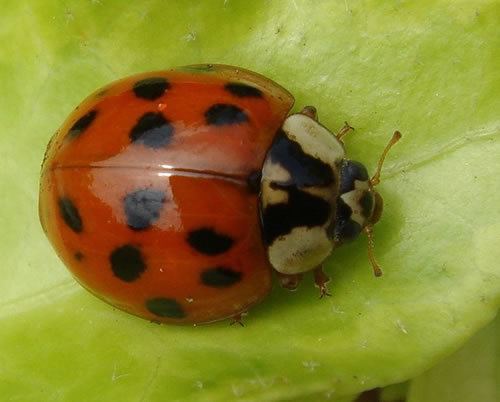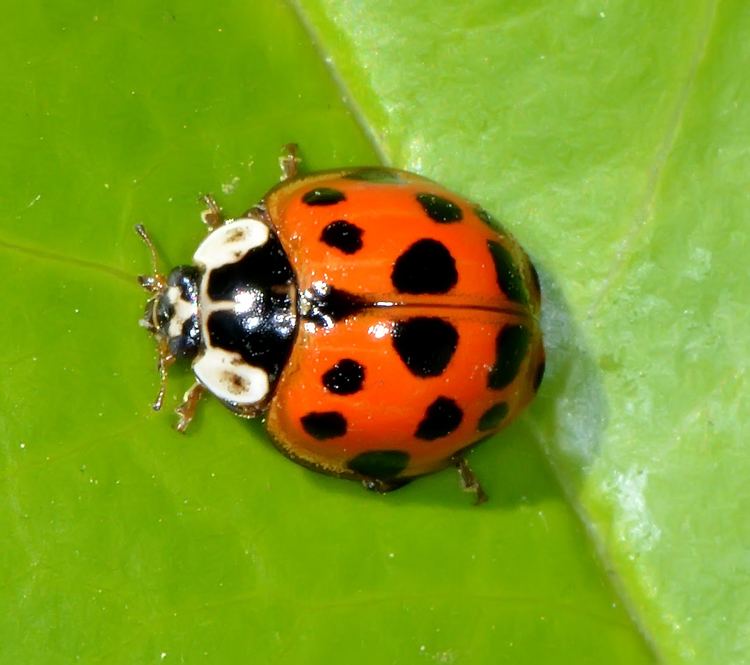Order Coleoptera Rank Species | Family Coccinellidae Scientific name Harmonia axyridis Higher classification Harmonia | |
 | ||
Similar Ladybird, Harmonia, Insect, Beetle, Coccinella septempunctata | ||
Harmonia axyridis, most commonly known as the harlequin, multicolored Asian, or simply Asian ladybeetle, is a large coccinellid beetle. This is one of the most variable species in the world, with an exceptionally wide range of color forms. It is native to eastern Asia, but has been artificially introduced to North America and Europe to control aphids and scale insects. It is now common, well known, and spreading in those regions, and has also established in South Africa and widely across South America.
Contents
- Japanese lady bug harmonia axyridis
- Description
- Range
- North America
- Worldwide propagation
- Biology and behavior
- Control
- Biochemistry
- References

This species is conspicuous in North America where it may locally be known as the Halloween ladybeetle. It earns this name as it often invades homes during October, in order to prepare for overwintering. In Japan, it is not generally distinguished from the seven-spot ladybird which is also common there.

When the species first arrived in the UK, it was labelled in jest as the "many-named ladybird" due to the great quantity of vernacular names. Among those already listed other names include multivariate, southern, Japanese, and pumpkin ladybird.

Japanese lady bug harmonia axyridis
Description

Harmonia axyridis is a typical coccinellid beetle in shape and structure, being domed and having a "smooth" transition between its elytra (wing coverings), pronotum, and head. It ranges from 5.5-8.5mm in size. The common color form, f. succinea, is orange or red in colouration with 0-22 black spots of variable size. The other usual forms, f. conspicua and f. spectabilis, are uniformly black with 2 or 4 red markings respectively. The pronotum is white with variable black patterning, ranging from a few black spots in an M formation to almost entirely black. The underside is dark with a wide reddish-brown border.

However, numerous other forms have also been recorded. Extreme forms may be entirely black all over, or feature unusual patterns of black, orange and red.
The large size of this species is usually the first clue to its identification. Despite variation, this species does not generally overlap in pronotal or elytral pattern with any other species, except in unmarked orange or red forms. In Europe it is similar to the much smaller Adalia decempunctata, while in America it is similar to the much narrower Mulsantina picta and spotless forms of Adalia bipunctata. When identification is difficult the underside pattern usually enables a reliable conclusion. Identification is most simple for the common forms, while less common varieties may take longer to identify. They always have reddish-brown legs and are obviously brown on the underside of the abdomen, even in the melanic colour forms.
Range
H. axyridis is native to eastern Asia from central Siberia, Kazakhstan, and Uzbekistan in the west, through Russia south to the Himalayas and east to the Pacific coast and Japan, including Korea, Mongolia, China, and Taiwan. As a voracious predator, it was identified as a biocontrol agent for aphids and scale insects. Consequently, it has been introduced into greenhouses, crop fields, and gardens in many countries, including the United States and parts of Europe. The species is now established in the United States, Canada, Argentina, Brazil, Italy, the United Kingdom, Denmark, Sweden, Norway, Finland, the Netherlands, Belgium, Luxembourg, France, Germany, the Czech Republic, Hungary, Croatia, Bosnia and Herzegovina, Poland, and South Africa.
North America
This species became established in North America as the result of introductions into the United States in an attempt to control the spread of aphids. In the last three decades, this insect has spread throughout the United States and Canada, and has been a prominent factor in controlling aphid populations. In the US, the first introductions took place as far back as 1916. The species repeatedly failed to establish in the wild after successfully controlling aphid populations, but an established population of beetles was observed in the wild near New Orleans, Louisiana, around 1988. In the following years, it quickly spread to other states, being occasionally observed in the Midwest within five to seven years and becoming common in the region by about 2000. The species was also established in the Northwest by 1991, and the Northeast by 1994, aided by additional introductions from the native range, rather than just reaching there from the Southeast. Reportedly, it has heavily fed on soybean aphids (which recently appeared in the US after coming from China), supposedly saving farmers vast sums of money in 2001.
Worldwide propagation
Worldwide routes of propagation of H. axyridis have been described with genetic markers in 2010. The populations in eastern and western North America originated from two independent introductions from the native range. The South American and African populations both originated independently from eastern North America. The European population also originated from eastern North America, but with substantial genetic admixture with individuals of the European biocontrol strain (estimated at about 40%).
This species is widely considered to be one of the world’s most invasive insects, partly due to their tendency to overwinter indoors and the unpleasant odor and stain left by their bodily fluid when frightened or squashed, as well as their tendency to bite humans. In Europe it is currently increasing to the detriment of indigenous species, its voracious appetite enabling it to outcompete and even eat other ladybirds. The harlequin ladybird is also highly resistant to diseases that affect other ladybird species and carries a microsporidian parasite to which it is immune but that can infect and kill other species. Native ladybird species have experienced often dramatic declines in abundance in areas invaded by H. axyridis.
In addition to its household pest status, it has been reported to be a minor agricultural pest contaminating crops of tender fruits and grapes in Iowa, Ohio, New York State, and Ontario. The contamination of grapes by this beetle has been found to alter the taste of wine.
Biology and behavior
H. axyridis becomes dormant in cooler months, though it will move around whenever the temperature reaches about 10 °C (50 °F). Because the beetles will use crevices and other cool, dry, confined spaces to overwinter, significant numbers may congregate inside walls if given a large enough opening.
These beetles make some use of pheromones to "call" each other, allowing for the large gatherings often seen in the autumn. This is exploited by the makers of H. axyridis traps. However, many cues are visual, both at long (picking out light-coloured structures that are distinct from their surroundings) and short (picking out pre-existing aggregations to join) ranges, while nonvolatile long-chain hydrocarbons laid down by previous aggregations also play a significant role in site selection. Both are more important than volatile pheromones.
They often congregate in sunlit areas because of the heat available, so even on fairly cold winter days, some of the hibernating beetles will "wake up" because of solar heating. These large populations can be problematic because they can form swarms and linger in an area for a long time. These beetles can form groups that tend to stay in upper corners of windows. This beetle has been also found to be attracted to dark screening material for its warmth. This beetle has good eyesight, and will come back from where it was removed, and is known to produce a small bite if provoked.
H. axyridis, like other lady beetles or ladybirds, uses isopropyl methoxy pyrazine as a defensive chemical to deter predation, but also contains this chemical in its hemolymph at much higher concentrations than many other such species, along with species/genus-specific defensive compounds such as harmonine. These insects will "reflex bleed" when agitated, releasing hemolymph from their legs. The liquid has a foul odour (similar to that of dead leaves) and can cause stains. Some people have allergic reactions, including allergic rhinoconjunctivitis when exposed to these beetles. Sometimes, the beetles will bite humans, presumably in an attempt to acquire salt, although many people feel a pricking sensation as a lady beetle walks across the skin, which is just the pressure from the ladybird's feet. Bites normally do no more harm than cause irritation, although a small number of people are allergic to bites.
These beetles can be difficult to identify because of their variations in color, spot size, and spot count of the elytra. The easiest way to identify H. axyridis f. succinea is to look at the pronotum and see if the black markings look like a letter "W" or "M" (depending on if the marking is viewed from the front or the back). Usually, more white is on the pronotum in this species than in most native North American species, though this is not useful if not comparing to North American species.
Control
Numerous methods of control have been investigated in areas where this beetle has been introduced and causes a threat to native species and biodiversity and to the grape industry. Methods of control include insecticides, trapping, removal of aggregates of beetles, and mechanically preventing entry to buildings. Methods under development involve the investigation of natural parasites and pathogens, including the use of parasitic sexually transmitted mites and fungal diseases.
H. axyridis traps are available that contain the pheromones used by the beetles to attract each other into large gatherings. The best methods for dealing with them in private homes involve sealing openings they may enter. Sweeping and vacuuming are considered effective methods for removing them from homes, though this should be done carefully so as not to trigger reflex bleeding. A nylon stocking placed inside the vacuum cleaner's hose, secured with a rubber band, allows the beetles to be "bagged" rather than collected inside the machine. A trap designed for indoor use was developed which attracts the beetles with a light and seals them in a removable bag, though as the beetles are not strongly attracted to light, this does not work particularly well.
Biochemistry
H. axyridis secretes a number of defensive compounds, one of which, (9Z,17R)-9-Octadecene-1,17-diamine (harmonine) has been isolated from its haemolymph. This molecule has been reported to have broad-spectrum antimicrobial activity that includes human pathogens. Antibacterial activity is most pronounced against fast-growing mycobacteria and Mycobacterium tuberculosis, and the growth of both chloroquine resistant Plasmodium falciparum strains is also inhibited.
